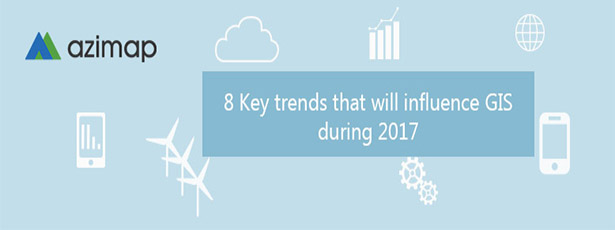News
Home | News | Key Trends Influencing GIS
Key Trends Influencing GIS

Geospatial intelligence has never been more important to enabling and enhancing the decision-making process in the interest of “Public Good”.
For the last number of years the geospatial industry has been heavily influenced by innovation and technology, as professionals demand tools which are reliable, faster and responsive to capture, visualise and analyse spatial data.
As 2016 comes to an end, we wanted to identify the trends which we feel will influence GIS during 2017. These trends are as follows –
Automation of complex data processing and analysis
An existing trend which has grown from strength to strength is the migration from manual data processing to a single automated process. During 2017 it’s projected that the automation of complex processing will continue to be streamlined via the use of the web-based processes, this is evident as ICHEC continue to develop a process to streamline remote sensing and GIS processes. This automation process shall be achieved by building either a graphical modeller geo-algorithm or by writing python scrips.
Migration from proprietary to open-source software
Demand for GIS, based on open-source principles increased dramatically during 2016. This is evident as web-based applications such as Azimap, MapBox, QGIS and GeoServer gained significant traction in a market place which is heavily served by proprietary applications.
The increase in demand for GIS based on open-source principles is an exciting development and once that will continue to gain momentum throughout 2017. This is evident as local governments promote the use of open source within government departments. For GIS professionals and customers it means they can make informed decisions based on the benefits of open source when compared to a proprietary application.
Integration of geospatial technologies
We recently had an opportunity to exhibit and present Azimap at INTERGEO, the world’s largest Geo Spatial event. Upon reflection of this event, it became apparent that the integration of geospatial technologies with existing processes has become essential for businesses aiming to become more efficient.
During 2017 we predict businesses will look at GIS as a business transformation tool, with the objective of using GIS to become a centralised repository for processing, analysing, publishing and sharing geoinformation.
Remote sensing and data capture analysis
Throughout 2016, remote sensing and data analysis technologies played a pivotal role. Remote sensing has continued to evolve dramatically from the generalised use cases within the agriculture, forestry, weather and biodiversity to become the eyes in the sky for areas affected by disaster, climate change, forest disease and wild fires. For example, unicef are dependent on remote sensing and visualisation to help coordinate the delivery of emergency relief.
Whilst we predict that remote sensing and data capture analysis will continue to be used for the greater good, it’s envisioned that the analysis of applications will become more efficient to support the processing of large datasets. We predict that cloud based applications developed on open-source principles will gain significant traction, as businesses strive to streamline the data capture, analysis and publishing process.
Web-based application development
A key trend in GIS visualisation is to move away from standalone pdf or paper based maps to more dynamic and relational web applications. This migration will enable the user to visualise their data and relate it other data sets, ie field mapping no longer being paper based. Instead it will consist of apps where an end user can access it on their individual devices and save their sessions without the need of paper maps.
However please don’t dispose of your paper map, if you enjoy trekking and exploring the many national parks or nature reserves.
Fast reliable software
A recent survey by WBR Digital reported that customers are demanding more reliable, faster and mobile solutions that will work from any location and in real time. To fulfil this demand throughout 2017 we will continue to optimise Azimap’s performance to reduce map loading times and to ensure an optimum experience when using the application from any mobile device. We also project that alternative GIS products will also focus on enhancing the user experience.
Open Data
Throughout 2016, publishing and sharing of Open Data for public consumption became a major priority for local government, as they attempted to become more transparent in the interest of ‘Public Good’. We expect the trend of open data to continue throughout 2017 with many GIS professionals claiming that the availability of open data has become one of the most significant cultural shifts within the GIS industry for many years.
Brexit
Brexit has been a hot topic of conversation since the UK voted to leave the European Union. The shock result of this referendum caused shock waves across the globe and has left an air of uncertainty within the business sector. This is evident as figures suggest that within the days immediately after the Brexit vote 73% of finance officers claiming that their company’s prospects have been become gloomier.
However, the reality of Brexit is still of uncertainty so we must remain optimistic and positive about the prospects that this opportunity could bring for business especially for those looking to export and form now partnership and relationship in new markets. Brexit will continue to be a hot topic of discussion; however, the reality of life and in business is mind set of thinking that the glass in always half full!
While we appreciate that the trends we identified will help to shape the GIS industry throughout 2017, the one key significant focus of GIS will be how it can be utilised for the greater good people.
Focusing on the benefits of how GIS technology can be utilised to enhance communities, deliver humanitarian aid, improve infrastructure and implement disaster recovery plans is exciting and rewarding for professionals operating within this industry.
Don’t forget to share what your opinion of what will be the key topics to influence GIS in 2017 as we would love to hear them.



